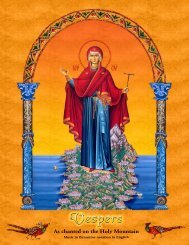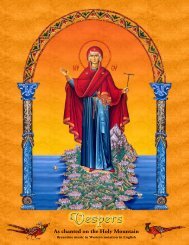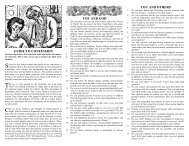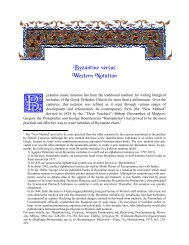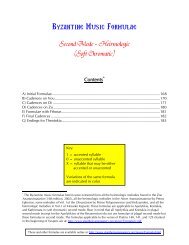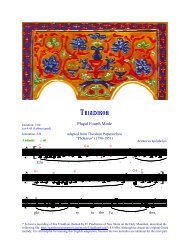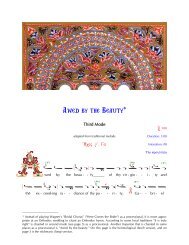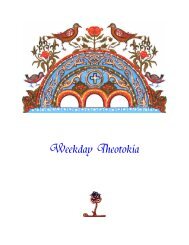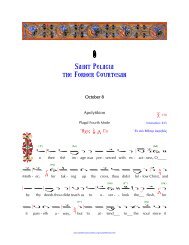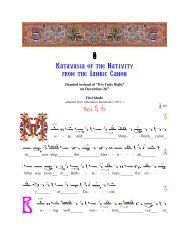Reading Psalmodia (PDF) - St. Anthony's Monastery
Reading Psalmodia (PDF) - St. Anthony's Monastery
Reading Psalmodia (PDF) - St. Anthony's Monastery
Create successful ePaper yourself
Turn your PDF publications into a flip-book with our unique Google optimized e-Paper software.
Similarly, in the eighteenth and nineteenth centuries the more elaborate settings of somepsaltic composers were influenced by the melodies of the Italian opera.The notation system in which Byzantine chant is recorded derives ultimately from theaccents added to classical Greek texts by Alexandrian grammarians and rhetors, and thenadapted for use to aid the musical declamation of scriptural texts. Eventually, the notationbecame complicated in the extreme, signs indicating the principal intervals of the melodybeing accompanied by a wealth of Great Hypostases, usually written in red ink,determining in minute detail the precise execution of the melody. In the modern periodscholars have work hard to decipher the mediaeval musical manuscripts. The meaning ofthe signs for intervals seem reasonably solidly established. There remains, however,considerable disagreement as to the interpretation of other signs.Facing the complex and difficult notation they inherited from their mediaeval predecessors,and an emerging gap between the musical texts used by expert psaltai and the traditionalliturgical melodies handed down by ear, several musicians attempted to reform the notationto produce something simpler and more intuitive. Indeed, there is evidence that there hadalready emerged ways of writing a rapid “short-hand” version of the signs which couldeven be used to note down a melody as it was being sung. A particularly successfulsimplification was designed by Peter Lampadarios [+1777], but this was eclipsed by thegreat Reform of the Three Teachers, Houmouzios, Grigorios and Chrysanthos, whodesigned a simpler yet more analytic notation, and transcribed into it a colossal number oftexts from the psaltic repertoire. The new notation indicates the precise duration of notes,something lacking in the old notation. The Three Teachers began their Reform about 1814and the new notation was soon in wide use. Interestingly, the Protopsaltes (Archcantor) ofthe Patriarchal church, Konstantinos, disliked their new system, and continued to use theold with the right-hand choir, while his colleague, the Lampadarios, and the left-hand choirwere using the new. This brief text is an introduction to the nature of the ReformedNotation and the chant written in it.1. NOTES AND SCALESByzantine chant (<strong>Psalmodia</strong>) makes use of a variety of different modes, and in order tosing the chant it is necessary to know the different scales proper to each mode, and theother characteristic features of the modes.The modes of Byzantine chant are organised into Eight Tones or Echoi. Each echosencompasses a cluster of related modes. (Other modes also exist which are produced bycombining the typical modes of different tones. Some of these are of considerable musical interestand importance, but none of them is used more than occasionally in <strong>Psalmodia</strong>.)A psaltic mode is not simply a scale. Indded, different modes sometimes use the samescale. Each mode uses both a specific scale and a set of typical melodic formulae, ormelodic loci; as the formulae typical of a particular mode become familiar, the musical"logic" of the mode becomes intelligible.5



